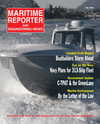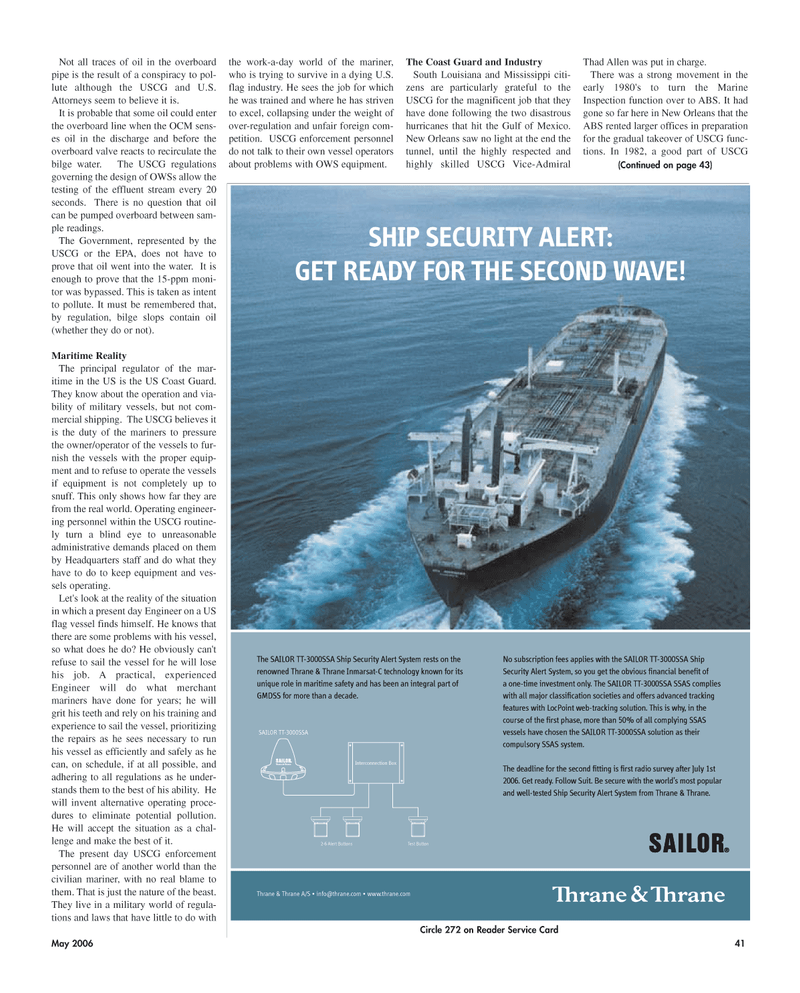
Page 41: of Maritime Reporter Magazine (May 2006)
The Marine Enviroment
Read this page in Pdf, Flash or Html5 edition of May 2006 Maritime Reporter Magazine
May 2006 41
Not all traces of oil in the overboard pipe is the result of a conspiracy to pol- lute although the USCG and U.S.
Attorneys seem to believe it is.
It is probable that some oil could enter the overboard line when the OCM sens- es oil in the discharge and before the overboard valve reacts to recirculate the bilge water. The USCG regulations governing the design of OWSs allow the testing of the effluent stream every 20 seconds. There is no question that oil can be pumped overboard between sam- ple readings.
The Government, represented by the
USCG or the EPA, does not have to prove that oil went into the water. It is enough to prove that the 15-ppm moni- tor was bypassed. This is taken as intent to pollute. It must be remembered that, by regulation, bilge slops contain oil (whether they do or not).
Maritime Reality
The principal regulator of the mar- itime in the US is the US Coast Guard.
They know about the operation and via- bility of military vessels, but not com- mercial shipping. The USCG believes it is the duty of the mariners to pressure the owner/operator of the vessels to fur- nish the vessels with the proper equip- ment and to refuse to operate the vessels if equipment is not completely up to snuff. This only shows how far they are from the real world. Operating engineer- ing personnel within the USCG routine- ly turn a blind eye to unreasonable administrative demands placed on them by Headquarters staff and do what they have to do to keep equipment and ves- sels operating.
Let's look at the reality of the situation in which a present day Engineer on a US flag vessel finds himself. He knows that there are some problems with his vessel, so what does he do? He obviously can't refuse to sail the vessel for he will lose his job. A practical, experienced
Engineer will do what merchant mariners have done for years; he will grit his teeth and rely on his training and experience to sail the vessel, prioritizing the repairs as he sees necessary to run his vessel as efficiently and safely as he can, on schedule, if at all possible, and adhering to all regulations as he under- stands them to the best of his ability. He will invent alternative operating proce- dures to eliminate potential pollution.
He will accept the situation as a chal- lenge and make the best of it.
The present day USCG enforcement personnel are of another world than the civilian mariner, with no real blame to them. That is just the nature of the beast.
They live in a military world of regula- tions and laws that have little to do with the work-a-day world of the mariner, who is trying to survive in a dying U.S. flag industry. He sees the job for which he was trained and where he has striven to excel, collapsing under the weight of over-regulation and unfair foreign com- petition. USCG enforcement personnel do not talk to their own vessel operators about problems with OWS equipment.
The Coast Guard and Industry
South Louisiana and Mississippi citi- zens are particularly grateful to the
USCG for the magnificent job that they have done following the two disastrous hurricanes that hit the Gulf of Mexico.
New Orleans saw no light at the end the tunnel, until the highly respected and highly skilled USCG Vice-Admiral
Thad Allen was put in charge.
There was a strong movement in the early 1980's to turn the Marine
Inspection function over to ABS. It had gone so far here in New Orleans that the
ABS rented larger offices in preparation for the gradual takeover of USCG func- tions. In 1982, a good part of USCG
SHIP SECURITY ALERT:
GET READY FOR THE SECOND WAVE!
Thrane & Thrane A/S • [email protected] • www.thrane.com
The SAILOR TT-3000SSA Ship Security Alert System rests on the renowned Thrane & Thrane Inmarsat-C technology known for its unique role in maritime safety and has been an integral part of
GMDSS for more than a decade.
No subscription fees applies with the SAILOR TT-3000SSA Ship
Security Alert System, so you get the obvious financial benefit of a one-time investment only. The SAILOR TT-3000SSA SSAS complies with all major classification societies and offers advanced tracking features with LocPoint web-tracking solution. This is why, in the course of the first phase, more than 50% of all complying SSAS vessels have chosen the SAILOR TT-3000SSA solution as their compulsory SSAS system.
The deadline for the second fitting is first radio survey after July 1st 2006. Get ready. Follow Suit. Be secure with the world’s most popular and well-tested Ship Security Alert System from Thrane & Thrane.
Interconnection Box
SAILOR TT-3000SSA
Test Button2-6 Alert Buttons
Circle 272 on Reader Service Card (Continued on page 43)
MR MAY2006 #6 (41-48).qxd 5/8/2006 11:55 AM Page 41

 40
40

 42
42
